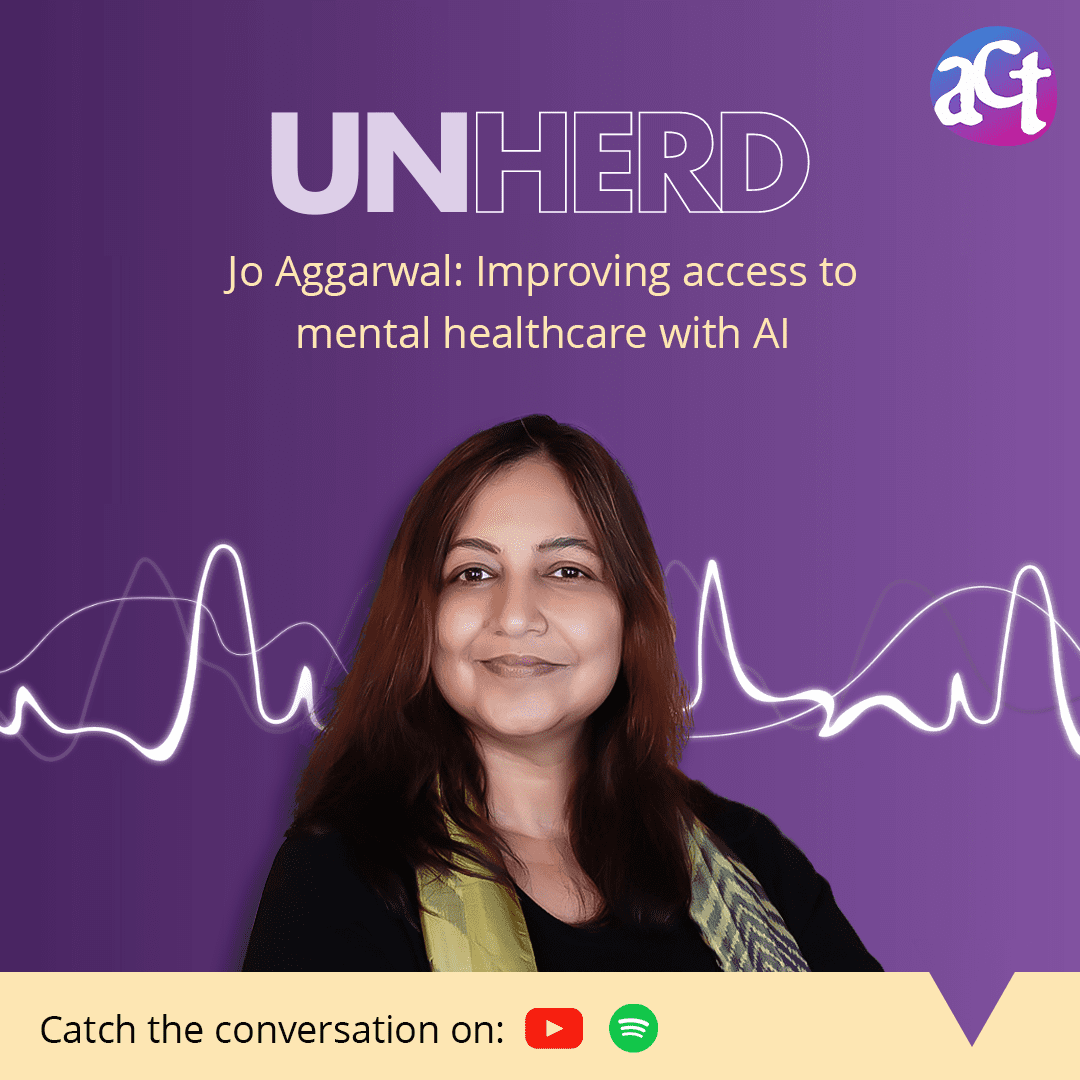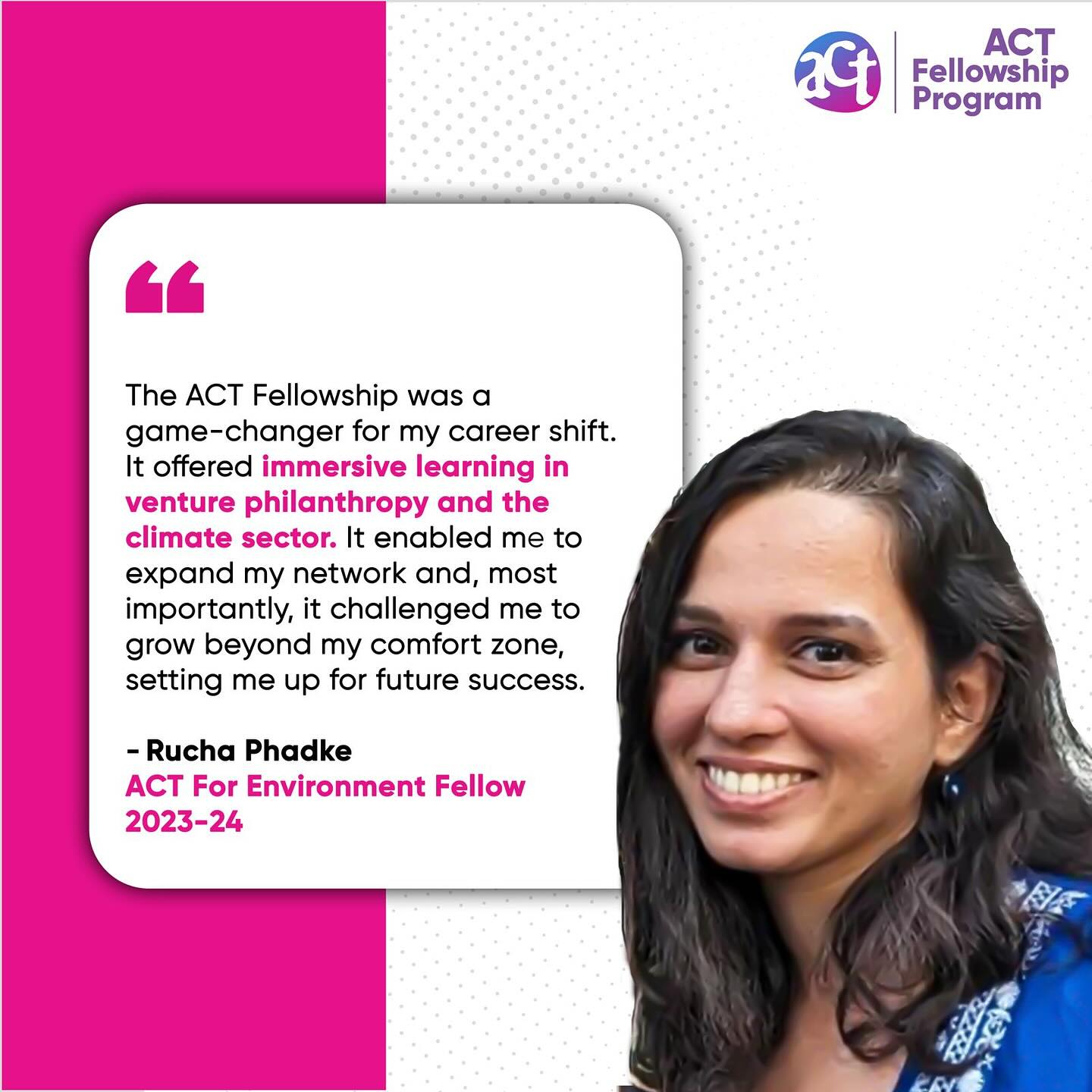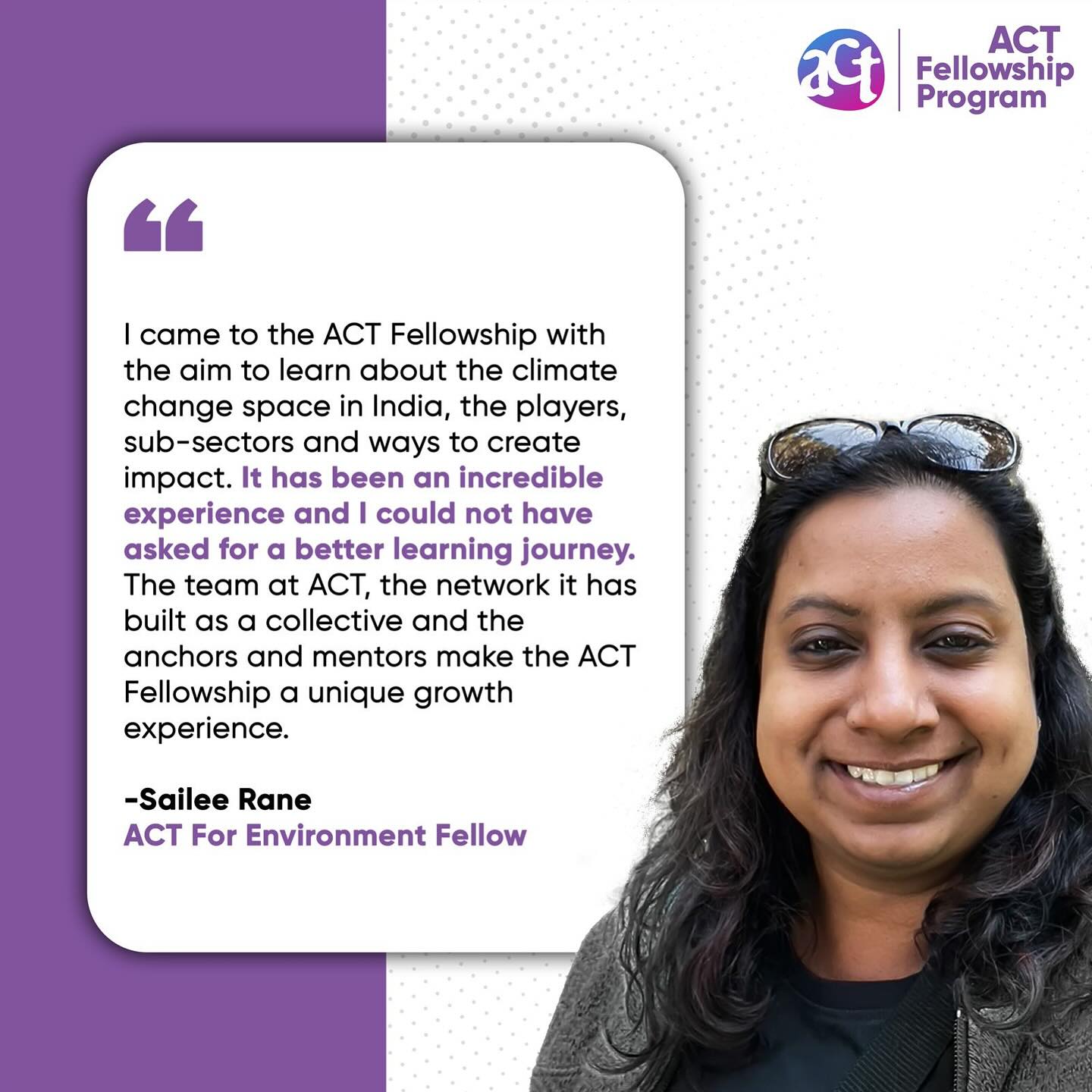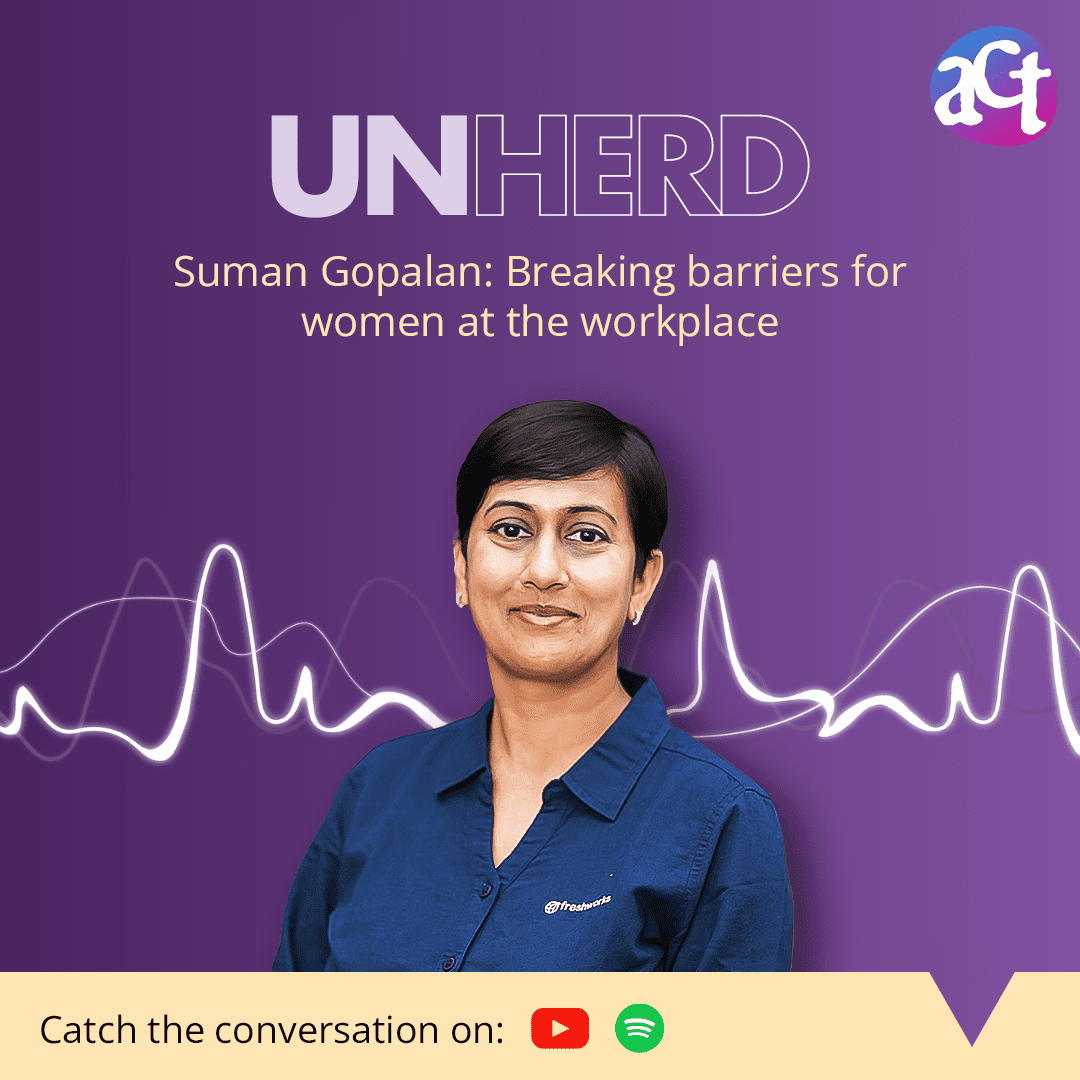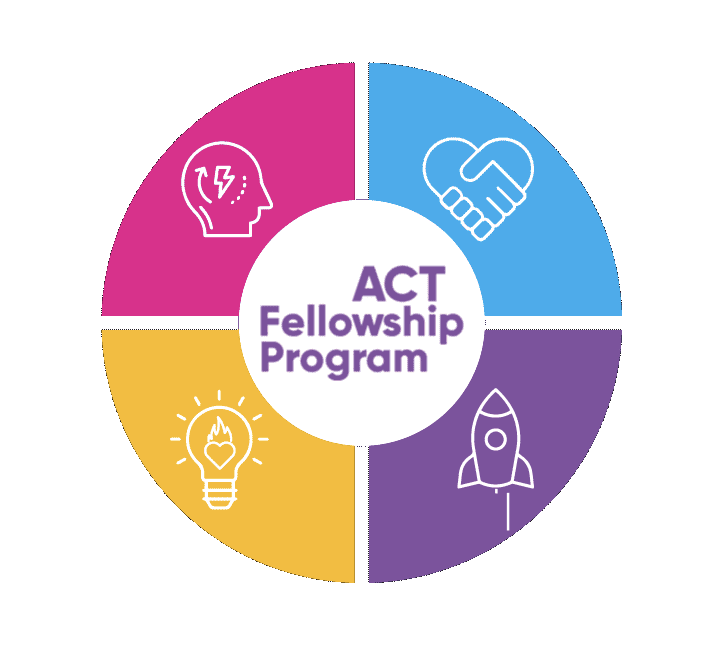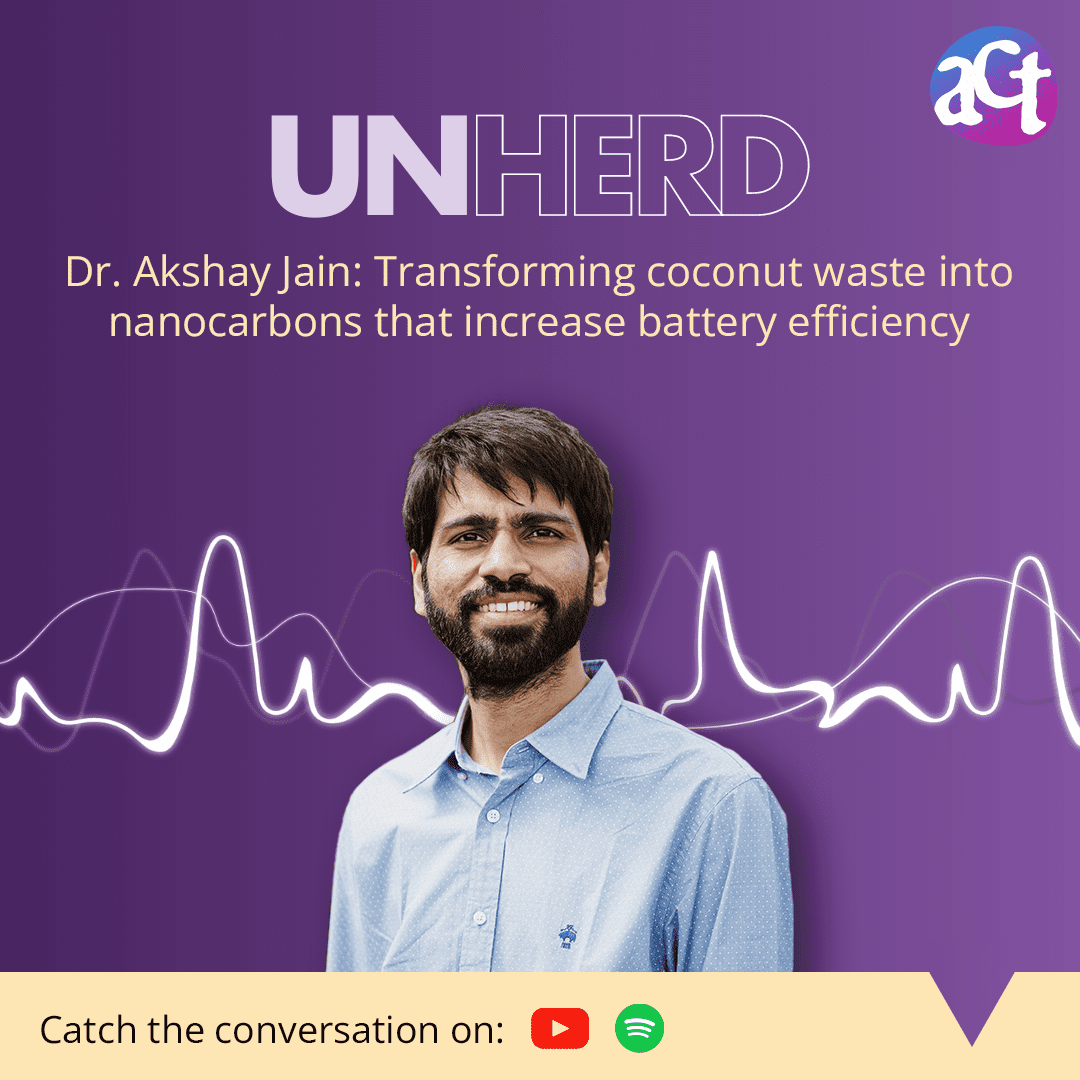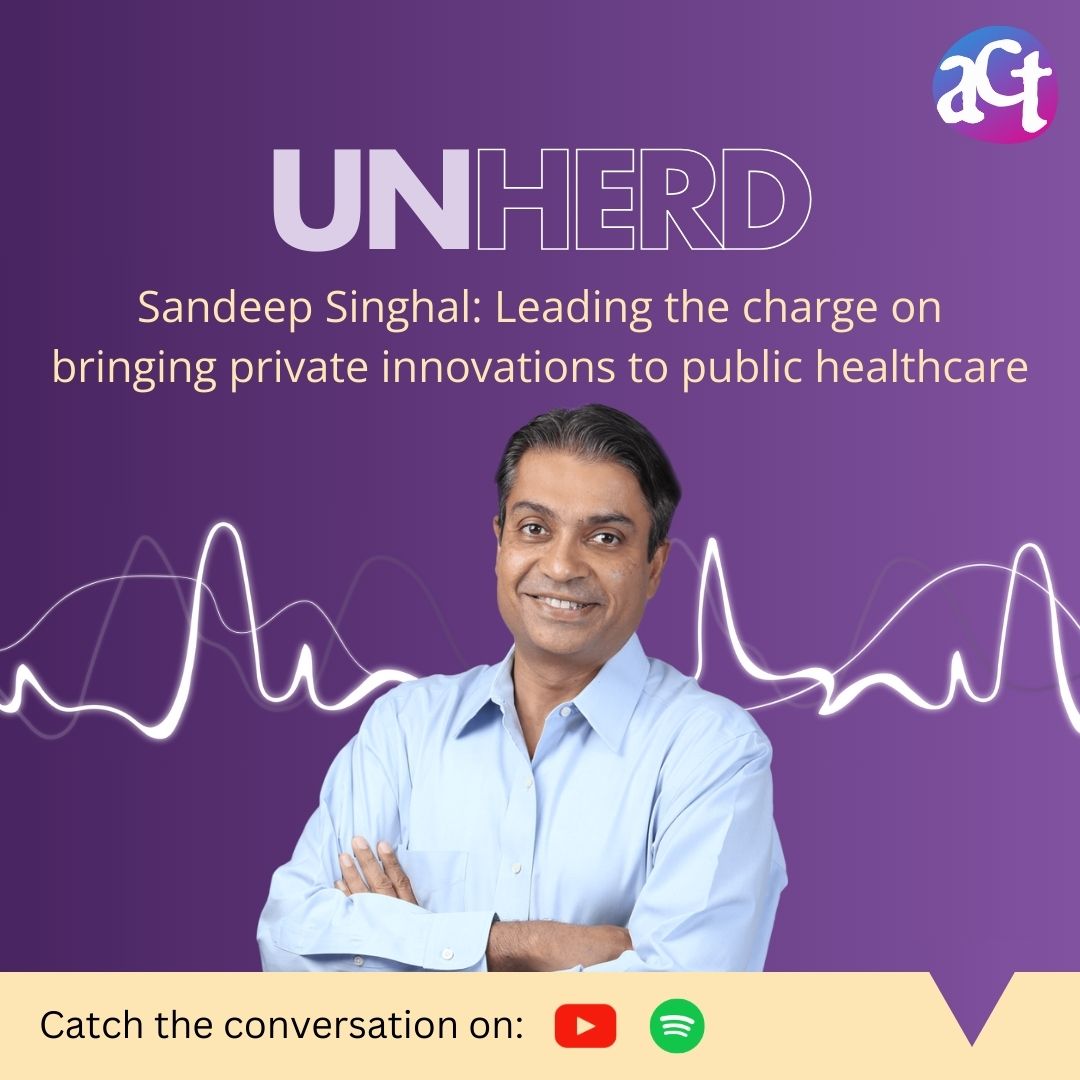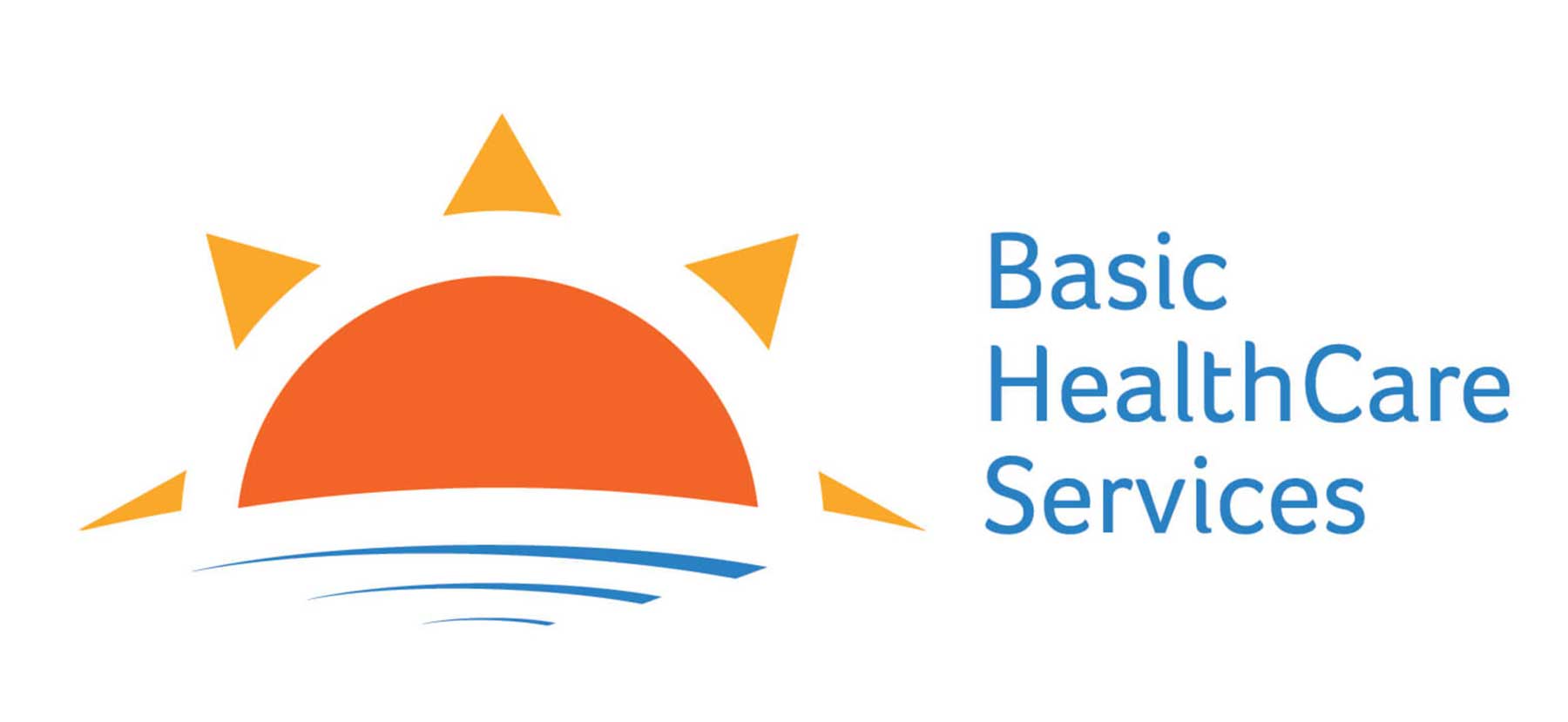Hosted by ACT, UnHerd brings you the unheard stories of individuals who are challenging conventional principles to disrupt the social impact landscape. From social entrepreneurs to venture philanthropists, dive into real-world conversations on what they’ve experienced and learned about changing the status quo.
Our fifth episode welcomes Jo Aggarwal (Co-Founder, Wysa) who, in conversation with Krisha Mathur (Director, ACT For Health), shares her experience of building a vernacular AI-powered digital solution that aims to make mental healthcare easily accessible and affordable for Bharat.
Listen to this episode on our Spotify channel or watch the conversation on YouTube.
Krisha: Hello folks and welcome to the fifth episode of Unheard, a podcast hosted by ACT that delves into the extraordinary stories of individuals who are challenging conventional principles to disrupt India’s social impact landscape.
Being a health-tech entrepreneur in India is a little bit like being Sisyphus who rolls the boulder uphill every day. It needs hard work, motivation, lots and lots of patience – only to begin all over again the next day. COVID has also taught us that while this is a hard space, there are many challenges that are lurking beneath the surface that we have barely begun to scratch.
One such issue in India is the mental health challenge, affecting almost 1 in 5 Indians and with extreme social and cultural stigma. But while the scale and complexity of this issue may be a challenge, we also have determined entrepreneurs driving innovative tech, showing our shoots of green. Our guest today is one such entrepreneur, a pioneer in this space with a personal journey working ground up in the corporate sector. After spending 6 years in the Middle East trying to help young people thrive in a post-conflict environment, she and her partner realised that it didn’t take big money or big names to make impact, but it takes commitment to build a strong product, perseverance to work on the ground, and above all, to keep the user always first. Today, she and her partner are trying to solve the mental health issue through their AI-first venture, Wysa, supporting almost 6 million users globally.
Welcome to UnHerd, Jo. So lovely to have you here!
Jo: Lovely to be here.
The spark that lit the fire: Overcoming personal battles to help others
Krisha: I want to start by going back to where it all began. Your journey has been so non-linear and so interesting. In your own words, can you describe your story to us and what helped you build Wysa?
Jo: So, I went through life always wanting to be an entrepreneur, a social entrepreneur rather. We were just born a little too early when entrepreneurship wasn’t as accessible to people without that background and neither was social entrepreneurship to people who wanted to have a good life as well. It was all non-profit, so one became a part of the most ‘happening’ thing – putting India on the map at that moment – which was the IT sector. I was one of the first batches of Infosys. And at each point, I asked – how do I actually do this with a little more meaning? So I moved from tech to e-learning, because it felt like it could actually solve a real problem. Then I moved from that to skilling and jobs and employability because it felt like it was the main thing that everybody really needed to solve for young people, especially in this part of the world and in the Middle East and North Africa. My aspiration was always to become something like a Wikipedia, because I was in e-learning and then Wikipedia came along and solved the problem I wanted to solve for e-learning. But if you run a business to business, a sort of B2B business, then you’re always limited by your clients’ needs. So, could I do something that was more B2C, more direct to the consumer? Could I do something that wasn’t hampered by grants and the grant cycle and which started by proving itself in the hands of a user first?
That was the idea. We started out trying to do elder care for some reason. Elder care was a very personal reason for my partner. We came back to India to parents who were in a much different life stage than we had left them and said we need to do something for remote care. But that product kept getting used by people to track their teenagers! I went into depression because I was like, this is my first entrepreneurial adventure. I can’t close it down, but I can’t let it become this either.
And so we started on that “depression journey”. I came out of it learning about Cognitive Behavioral Therapy, experimenting with Artificial Intelligence as a way of feeling heard for the first time with a bot called ‘Eliza’ and thinking that I want to make something like Eliza, but only wiser, and that’s where the name Wysa came from.
But just the power of CBT, the power of reframing one negative thought, and for me that negative thought was that no matter what I do, I’m going to fail, that I’m an imposter, that every success I’ve had, has been me telling stories to the world – which I’m good at – but in real impact, I’m going to fail no matter what I do. That was the core thought I was able to identify through CBT underneath my depression and anxiety. And from that thought, it was reframed into a thought to say that, okay, even if that’s true, even if that’s valid, I still have to do something, so what am I willing to fail at doing? And I found that I was willing to fail at doing something really big. When that thought comes, you don’t want to fail at small things. You don’t want to fail at doing a startup, you want to fail at solving climate change. So for me, it was wanting to fail at solving global mental health.
It’s very miraculous how overturning a single thought can change your emotional and your behavioural reactions. So we started out by just repurposing what we’d built and we had a little chatbot that was associated with it, because I had this keeda that maybe it’ll work. So I built a little chatbot, which was just multiple choice, no AI alongside it. But we just repurposed our tracking of where an elderly person was. By tracking depression and anxiety, we were able to see where the people were.
There was one lady who came with her husband in a burkha and took a PHQ-9 GAD-7 and did not show any depression signs, while our passive sensing was showing that she should be depressed. We were able to ask the doctor, “What happened? This person should be depressed. Why are you saying she’s not?” and we found out that she needs to be called again individually, that she was severely depressed and suicidal. So these kinds of things were happening, but nobody was getting therapy. And we thought, yes, we might detect that somebody has depression, but if there’s no support available, what’s the point? We’re not solving anything here.
But the people who were using the chatbot were actually showing markedly reduced depression signs. That made us really think this is possible. But you still don’t feel like you have the permission to do something in a space that you know nothing about. I thought, I’m not a doctor, I’m not a psychologist. So, we went to Dr. Vikram Patel, who now is at Harvard Medical College. We showed him our data and we said, “What’s happening?” And he said, “Even asking a person how they are is therapeutic. What you’re doing is therapeutic. And this is the future of how access is going to be created. Keep doing this.” That gave us a lot of faith. If the people at the top of this wheel believe that this can happen, and if it’s a skill that can be built, then I know how to do skilling for people! So I think I just went back to the core of what I knew how to do, which was skilling, and then started building Wysa from there.
Traversing tough roads: The three pivots every entrepreneur must think through
Krisha: This is such a fascinating story, Jo, and thank you for also sharing the personal story behind it. I think we keep hearing that being a founder is about failing fast, learning fast, pivoting fast. Your journey clearly has a lot of pivots along the way. What have been these big pivots (for you) and what has driven them?
Jo: You talked about Sisyphus; sometimes I feel like it is more like the Ship of Theseus. You keep taking away parts and putting them back in (and wonder) if it’s even the same company anymore. I think it’s important for you to pivot a product if it’s not finding product market fit. And those pivots are happening till date.
The (first) pivot started when we were doing an elder care product and pivoted thrice within the elder care product, which finally ended up from a hardware device to an app. And so they were varied product pivots mainly because of either the ability to differentiate yourself in the market or raise funding and so on and so forth. There’s some pivots that you’re doing at a seed stage just because you need product market fit with investors. The second type of pivot is in the hands of the user. The hardware was a great product market fit in the hands of the user. But no investor wanted to fund it. And what investors wanted to fund, was a really leaky bucket. Get x number of downloads and they then send it to other people; for those other people, it’s too new a concept and so, they don’t download it. So there was no PMF. And when you don’t get PMF, it’s really important to pivot fast because it can really drain your energy. The more effort you put in, the less rewards you get. And that really makes you question everything about yourself.
So from there, we went into solving a tech problem, which was passive sensing, and that would have had a good investor tracking, but for us that was not going to solve the problem. So there was a mission pivot. Are we even doing something that is mission-aligned, because we said we’re willing to fail at solving global mental health. Now, if it’s not going to solve global mental health, that hypothesis has failed, even if you’ve got investors backing it. This is the pivot that I feel we did because we were committed to solving the problem. And that makes all the difference. So over the years, walking away from certain investors, walking away from people who said you have to focus only on the US or the UK and not the rest of the world, walking away from big brand investors, and all of that just so that you can have a shot at solving this problem.
So in India, Wysa is not mental health. In India, Wysa is now Mann Ka Coach, Jo Badle Soch. It’s skilling because there are budgets for skilling. India spends 100 million dollars on mental health of which 80 million goes to NIMHANS. But there isn’t really a budget for early stage preventative mental health. Everybody understands the need, that the reason you’ll succeed or fail is mental resilience. So I’ve come back into that skilling space and a lot of the work that we’re doing with ACT, with adolescent girls, young mothers, with gig workers, all of that is coming from a skilling space and that is really scaling.
Krisha: That’s so interesting to hear and you know, listening to you, I’m also sort of recalibrating what an amazing journey we’ve had with you over the last year or so, just taking Wysa to India [Bharat] – seeing firsthand how difficult it is to take a tech-first solution to the last mile. Jo, while you’ve talked about challenges on the ground and early failures, there have also been early wins which have helped you figure out this journey along the way. I know there’s many many anecdotes from the ground. Would you like to share with us what these user journeys have been, what has given you early validation that you’re on the right track?
Jo: Absolutely. The first one was six months after launching Wysa. I always wanted to be an entrepreneur. He (Jo’s partner – Ramakant Vempati) didn’t. He could walk into a job and earn more money than we were trying to raise in our seed funding. But he said he would stay if we were able to, you know, prove that this actually worked.
And so we were reaching the end of our six months that he’d given us to prove it. And we got this mail from a girl, from the US, where we never did any marketing. We had no idea that people in the US were using us. And this girl said, “I’m 13. I tried suicide and you’re helping me hold on to myself. Thank you.” And it just broke our hearts. At that point, my partner and I, we just hugged and we said, “Okay, this has a real shot at solving the problem. And you know that you found that product market fit on solving global mental health when somebody who doesn’t know anything about you, who you’ve never tried to reach and who absolutely needs this, finds it useful.
And the second big milestone was meeting Emma. I met Emma, who was a nurse in the NHS. She said, “You guys don’t know, but you’re a legend here.” She’d been one of our early users and had been using Wysa for over a year already when she met us. She said, “Look, I have all these young people who come in and we have long waiting lists; we can’t give them anything. So, I’ve been looking for what to give them. I’ve been trying all the different apps out there, and I started giving them the free version of Wysa. A third of them didn’t need anything else. Especially people with learning disabilities, people who are on the spectrum, they actually preferred this because they don’t like talking to other people.” And then she of course said, “But you guys have to also do this, this, this, and this, and make sure that I can actually prescribe this properly.” So she had actually found a scholarship and was working part-time for free with us for the next year on that scholarship. Just to help us sort all of it out, she became a Clinical Safety Officer and helped us break into the clinical world. We began to understand what it takes to become a digital therapeutic.
I think with India now, we have a number of these stories come out. We had done the first study of type 1 diabetes patients in Aurangabad. These patients come from the semi-rural areas around Aurangabad as well, it was one access point that we had. And we gave our Hindi app to them. They’re young people who are also struggling with diabetes. And one of the toughest things that happens, especially to adolescent girls there, is that their form of rebellion tends to become not taking insulin. So any issue, from a relationship or mental health perspective, turns into them not taking insulin and they land up in an ICU. So it’s a really vulnerable population. And one of the girls said this to her mother. Now, the mother came back to us and said, “Can I also use the app?” We said, “Why?” And she said, “We always thought my daughter was mentally weak, she’s always very quiet, but since she’s been using this app, she talks to it every day. She comes and tells me, look, why can’t you talk the way this one [the app] talks? Look, it tells me I’m OK as I am, that I’m quiet and I’m alone, and that it’s OK to be like that.” The girl was feeling the sense of validation and self-concept, which is so rare in India. She was able to communicate that, using the app, to her mother and her mother was agreeing to change how she thinks about her daughter. And I just felt that if we can make a change at that most intractable space, if we can reach there, then we can change the world. And that’s really where my mission is now stemming from – to get 10 million people in India to use this every day.
First principle lens: Self-efficacy as a lens to find the right collaborators
Krisha: That is so incredibly moving, Jo, and thank you for sharing that. These stories are what keep us going everyday. Being an entrepreneur can sometimes be very lonely, but if you had to reach out and share your learnings with fellow entrepreneurs who are on the same path as you, what would you say?
Jo: Well, one is a rule I’d already learned before we set up Wysa. And I think it’s stood us in good stead. There is a concept that I live by called self-efficacy, which is defined as my confidence in my ability to achieve my goals. So that can apply to fitness self-efficacy or entrepreneurship self-efficacy, whatever your goal might be, but it has the highest correlation versus any other kind of resource you might have. If you have self-efficacy, then you’re more likely to achieve your goal than any other resource, money, power, anything.
And so no matter what people offered us, especially in the earlier stages but even today, no matter how close they were, no matter how big a brand they were, we had just one rule, which was did they increase their self-efficacy or not? And if somebody made us feel more confident that we would achieve our goal, then we’d bring them in. If not, no. And there are plenty of people on this journey who will make you feel like you can do nothing without them. But if they’re with you, you’d be amazing. If they’re not, then you’re just the same as any college kid trying to do something. They’re not increasing your self-efficacy, they’re increasing their own. So it’s really, really important to bring in partners who can do that in this journey.
Krisha: I think listening to you, I’m once again convinced that running a startup in India is not a solo sport. It’s a team activity. And I think founders have to deal with everything from building the product, then clinical validation, then figuring out the path to market. And it’s all relentless all the time. What do founders need to do differently to build better, faster, while being kind to themselves?
Jo: The one thing I always tell founders to do is not to seek validation from others, only to seek validation from revenue and users. So know where your product market fit lies. That investor product market fit is a very fickle thing. If it can dissuade you from doing something, it should. But don’t do something just because they [investors] are interested in it. Don’t use the investors as a way of saying, okay, if the investors are not interested, I won’t do it. Then you shouldn’t be doing it anyway. But if you absolutely want to do something, and the users like it and you can figure out a way to get the money, actually forget about the investors. Move fast, go B2C first if you’re trying to change the world because the users will actually teach you everything you need to know.
Because if you’re changing the world, then everything is either B2C or B2B2C. At the end of the day, your end person is a consumer. And if you’re a mission-driven startup, don’t lose that sense. If you do end up going B2B in a mission-driven startup, it’s very, very easy to start forgetting that you set this up for the user, not your client. And even within Wysa, we’re sort of reattaching ourselves to the users within our clients, because the clients can get you into so many different things that they care about, which have nothing to do with the user.
Almost every year you have to go back and remember why you set this up. Almost every year you have to found the company that you wanted to found originally. You have to find it again within the company that you founded.
Krisha: I mean there’s also the other side. B2C in India for digital products is actually not very easy. It’s actually a very expensive play. And while B2B may be easier, there’s also the cost side that you talked about. There’s financial sustainability. How do you think as a digital health founder, you can balance the two? Because it’s also not an easy journey – you do have investors to answer to, but you want to do good. So what does that balance look like between the two?
Jo: Think of it as three different product market fits. So you have your mission fit, you have your user fit, and you have your budget fit. There has to be a budget somewhere. A consumer might hold a budget. So consumers do pay. Look at the typical household budget. If you’re an education startup, you might be able to fit into their budget. But for mental health, that wasn’t an option because people who have mental health issues just do not have the money.
So for us, that became consumers only, but you still need product market fit for the consumer. Because everybody else will pay you because that consumer is actually deciding to use you and changing their behaviour, their thinking, creating that trusted space with you quickly. All of that is with the consumer. So you still have to start B2C because the more you intermediate yourself and the consumer, the less you learn.
And at the end of the day, what’s your theory of change? How are you actually going to solve the problem? Because that’s also a very easy one to get distracted from, between trying to do what the people with the money want you to do and do what the user wants you to do. Maybe you do both and still don’t solve the problem. So when you can get all three, then magic happens.
Future Forward: The Archimedian lever and GenAI for mental healthcare
Krisha: So if I got that right, you have to learn fast and learn first and then build for the customer – I think it’s a long journey by any standards, right? And the fact that you’ve gotten there and are getting there every day is what keeps us at ACT really, really excited. The mental health challenge globally and in India is what clearly is what’s driving you, is what you want to solve for. But helping people while balancing investors, helping people while doing good for the organisation is not easy. What do the next 4-5 years look like for you and what do you think it looks like for the sector, both globally and in India?
Jo: I think we are at that inflection point where we are poised to grow. We’re at the right place. We’re the world’s largest mental health chatbot. We’re making the most revenue of any chatbot in mental health and we have the most evidence, the most safety, the most privacy, all accredited internationally. And now we are well positioned with the advent of GenAI. Working with you, we’ve been able to bring it in low resource languages and redesign it, figure out our story, figure out a go-to-market, find partners within the government who are willing to support us. So find that sustainability path and figure out how it’s going to go to scale. I feel like in the next 5 years, it’s like Archimedes used to say, if we’re doing all these Greek metaphors – “give me a lever long enough and I’ll move the world.” And I think we’ve identified that lever.
Today, we are at 6.5 million across the world using it off their own volition. But that’s still not every day. That’s people who’ve downloaded the app and used it. So if we can get it to a level where people are just actively using this, changing how they think, then we truly can move the world. In the next five years, I want 10 million people using it every day. By 2035, we want to get to 60 [million].
Krisha: We know you’re really excited about where Gen AI comes in all of this. Do you want to tell us a little bit more about what you’re seeing in the offing and what about AI and mental health is getting you excited?
Jo: Everything. I feel like AI is finally delivering on the promise of computing. The original promise of computing, when those of us who were first introduced to computers, we imagined that computers would do what GenAI is doing today. We imagined that you could talk to a computer about things that nobody else would hear and that it would talk back to you. And a lot of the world for kids who are coming in today, when they look at GenAI, that’s the first thing they do. They talk to it about things that they can’t talk to their family about.
But now I’m seeing this everywhere. We had to explain to people why AI and mental health. And now almost every college has a dozen kids who are setting up a mental health chatbot with GenAI right? Because that’s just the most obvious use case. That’s what they’re talking to them about. So yes, AI, mental health.
But the big thing is that you really need something which is a good coach. And it’s like everybody can teach. So, Chat GPT can teach technically, but is everybody a great coach? Is everybody going to change your mind, build that therapeutic relationship? For that, you need that time, evidence, patience that we have spent over the last eight years. And you need that credibility of having published evidence, having had large partnerships, having done that with the safety and security. And that’s what we now bring in this post Chat GPT world to say, we figured out how to do it in a way that protects the user, that delivers the outcomes, that makes sure that there are humans in the loop, that there’s evidence against everything.
And I think it’s really important to have players like us because otherwise it’s just as easy for people to get disenamored by mental health and AI. It just takes one incident for everybody to just ban it. Right now, everybody understands the potential, but everybody’s a little scared about the fallout if something doesn’t go right. And we are here to show that you can actually reduce mental health risk with GenAI. So everything that goes out of Wysa has to demonstrate our legitimate use of AI, lowering mental health risk. And I think we’re paving the way there and setting up those standards that then hopefully will build an industry.
Krisha: This has been absolutely amazing, Jo. Thank you so much for joining us in this conversation.
This brings us to the end of our fifth episode of UnHerd – a podcast presented by team ACT. If you enjoyed this episode, subscribe to our Spotify and YouTube channels where we’ll bring you more unheard stories of people who are passionate about creating impact at scale in different ways. People who truly stand apart from the herd.
Follow us, like, subscribe and share!

